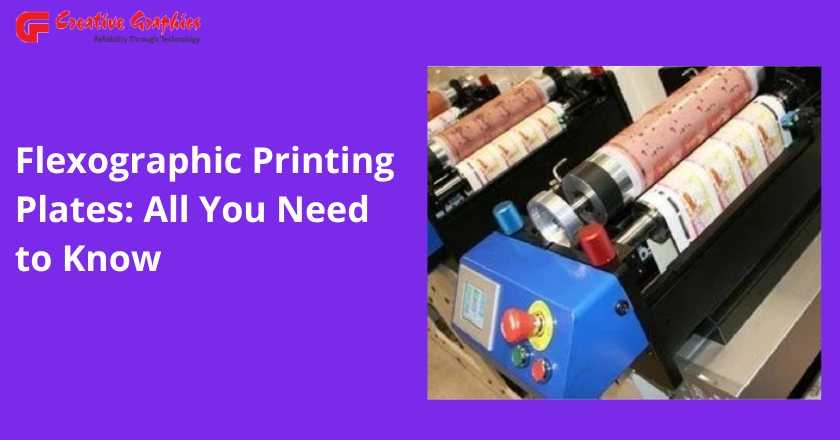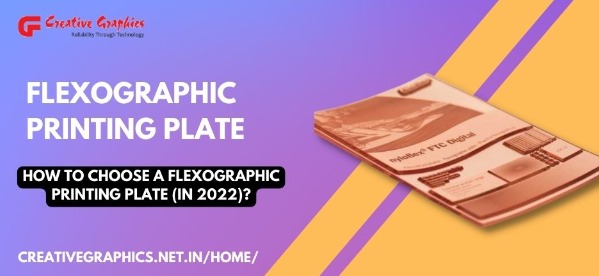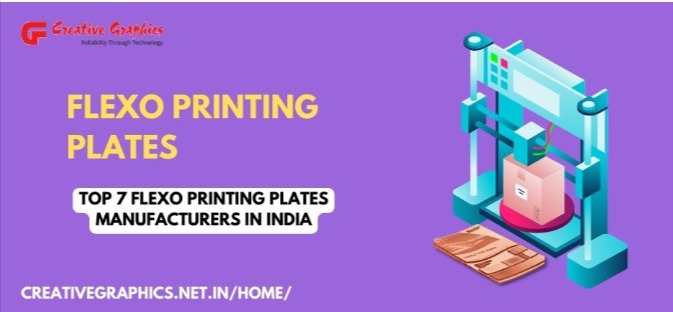Flexographic Printing Plates: All You Need to Know

A Step-By-Step Guide to Letterpress Printing Process ( 2022 Edition)
July 25, 2022
How to Compare and Choose Flexo Printing Sleeves?
August 10, 2022What is Flexographic Printing?
Flexographic printing is a form of relief printing that uses flexible printing plates. When a flexographic plate is inked, the ink adheres to the raised portions of the plate.
The substrate that will be printed on (typically paper or plastic) is then pressed against the plate under high pressure. This transfers some or all of the ink from the raised surfaces of the plate to the substrate.
The substrate can be of any form, including plastic, metallic films, cellophane, and paper.
It is essentially a modernized version of letterpress that has evolved with high-speed rotary capabilities.
These flexographic printing plates are typically constructed of metal in traditional flexography, but more recently, plastic and other materials like ceramics and even glass have also been made accessible!
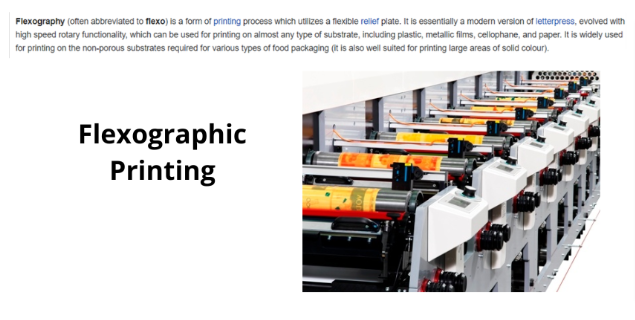
Flexographic Printing: How Does It Function?
In flexographic printing, the image is raised from the plate’s surface rather than being transferred from a different plate (as with lithography).
It is also known as rotogravure or gravure printing. The process involves using a rubber cylinder coated with ink to transfer an image onto paper or other materials such as labels, corrugated fiberboard, films, bags, etc., which are then used for packaging and labeling purposes.
The third method, rotary offset, combines offset and flexography but has some distinct features.
- It uses two plates: one for black ink (mostly text) and another for colours—usually cyan blue, magenta red, and yellow (CMYK).
- It uses four cylinders instead of one; these are called “docking knives” because they remove excess ink after each pass through them onto the substrate.
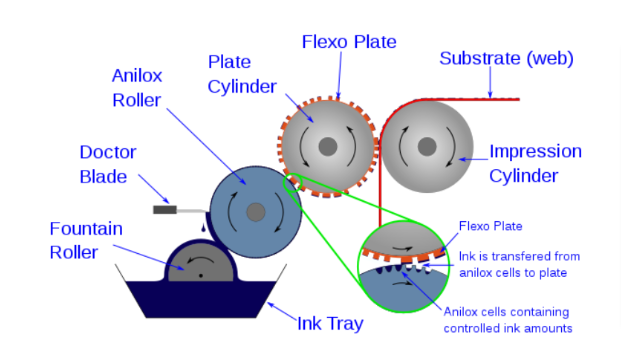
Definition Of Flexographic Printing Plates
In flexo printing, flexible photopolymer plates called flexographic printing plates are used to transfer ink and images on flexible substrates like paper or film.
The printing plates are a crucial component of the flexographic printing process, and they have a significant impact on the quality of the printed image.
Flexographic printing plates are a type of printing plate used in the flexographic printing process.
They’re made from a solid, flexible material, and they can be mounted on a press or used as a hand-held squeegee.
The main difference between these plates and other types of printing plates is that they’re made out of an alloy rather than steel or aluminum.
The benefit of this is that it allows for higher temperatures during production, which makes them durable enough to be used over time and multiple times without breaking down like traditional metals.
It implies that your flexographic printers won’t need to be replaced as frequently.
Numerous flexible substrates can be printed using the flexo technique, and the plates can be reused and re-used for millions of impressions.
Types of Flexographic Printing Plates
When it comes to flexographic printing plates, there are a variety of materials that can be used. These include aluminium, steel, zinc, and copper.
The type of material used depends on factors like the type of printing being done, the type of ink being used, and the size of the plate.
Examples:
- If you’re printing inks with low viscosity(fluid which flows easily as it has little friction), then you’ll want to use a softer metal like aluminium or copper so that they aren’t too thick when printed onto paper stock.
- If you’re using very thick inks with high viscosity levels(fluid can resist motion as it has high friction), then your best bet is going to be steel or zinc.
Steel or zinc plates tend not to bend as easily during use when compared with other substances, such as glass plates.
However, glass plates also work well due to their good durability but tend not to work as well overall once cut into smaller pieces before doing any kind of engraving work on them.
Contrary to the offset printing technique that uses fixed metallic printing plates, which are composed of metal, flexo plates are now constructed of photopolymer material in sheet form.
Previously, flexo plates were made of rubber. But nowadays, the plates can be wrapped around spherical print/plate rollers since they are sufficiently flexible.
Making the appropriate choice for your flexographic printing plate will enable you to produce printed products that are of high calibre and durability.
Which Are The Different Plate Processing Methods?
- Traditional Plate Processing Method
This method uses a laser image setter where the necessary picture is first exposed onto a film negative.
A vacuum cover holds it in place when it is placed directly on the material of the unexposed plate surface.
The picture is then fixed into the polymer material by exposing the plate and film to UV light.
The UV light can only penetrate the transparent portions of the negative film, which allows the UV rays to change the molecular bonds in the photopolymer substance.
The plate is attached to an oscillating plate and then placed into a washout tank after a long enough exposure time.
Depending on the kind of plate material, the washout solution may be water or solvent.
The polymer’s uncovered regions are then removed from the plate base using a washout brush.
The used polymer is dissolved in the washout solution before being processed for recycling or solvent reclamation.
The plate is then put in a hot air dryer after the washout procedure, where any extra water or solvent evaporates, leaving a dry plate.
The final plate must next undergo a post-cure utilizing both UVA and UVC lights before being ready for usage.
- Digital Plate Processing Method
The majority of flexo plates used nowadays are exposed directly from the computer to the plate (CTP).
The unexposed film negative is provided pre-laminated with the photopolymer sheet in this case so that both layers can be exposed using the same piece of equipment.
A computer controls a laser to expose the negative layer first, then the photopolymer is exposed to the UVA light source.
This exposure approach creates a plate of higher quality. The washout technique is then applied to the exposed plate.
- Thermal Flexo Plate Processing
This processing method does not require water or a solvent for the etching process, even though the exposure is a CTP procedure.
By applying heat treatment and a system of revolving rollers, the unexposed portions of the photopolymer are basically “melted” and eliminated.
Compared to traditional plate washing processing, it is claimed to be more environmentally friendly.
Get High-Quality Flexographic Printing Plates from Creative Graphics!
If you are looking for the best quality Flexographic printing plates, then Creative Graphics is the right choice.
We have a skilled group of employees who work hard to produce and supply Flexo Plates. These goods are created from premium raw materials that are purchased from trusted market vendors.
Flexographic plates are transported to the client’s location in specially designed packaging to prevent damage.
For more information about our flexographic printing processes, please feel free to contact us today!
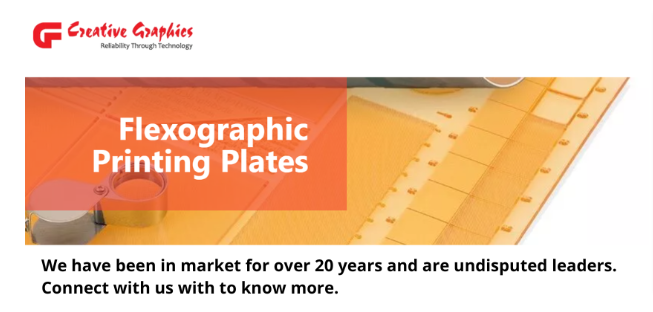
To Summarize
Flexographic printing plates are a great way to print anything from credit cards to coasters in large quantities. They’re also pretty easy to use, affordable, durable, and can be used with almost any machine out there. However, there are different flexo printing plate manufacturers are available in India.
FAQs About Flexographic Printing Plates –
Q.1 What distinguishes offset printing from flexo printing?
Ans- Offset printing can only be done on flat surfaces, whereas Flexographic printing may be utilized on virtually any substrate with a flexible surface. This is the major difference between the two techniques.
Q.2 Is flexographic printing costly?
Ans- Due to the need for printing plates, flexographic printing is typically more expensive than digital printing for small print runs.
Q.3 How do lithographic and flexographic printing differ from one another?
Ans- Bulk printing utilizing flexible relief plates is known as flexographic printing or Flexo. Lithographic printing, often known as Litho, is a printing technique that was originally founded on the incompatible ingredients of oil and water.

